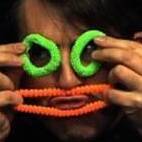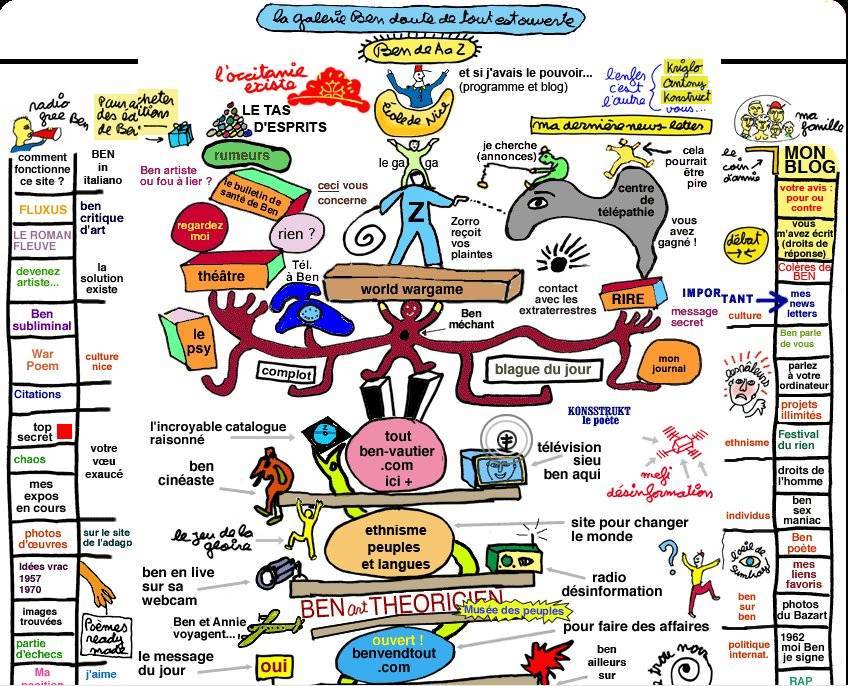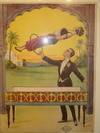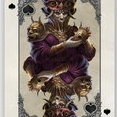Rechercher dans la communauté
Affichage des résultats pour les étiquettes 'Internet'.
-
ChatGPT dévoile les plus grands secrets de la magie
un sujet publié par Jacques TRRN dans Chemins de Traverse
Après avoir vu deux tours de magie qui m'ont bluffé, j'ai demandé à ChatGPT, le logiciel d'intelligence artificielle de me révéler le secret de ces tours : Question Quel est le secret du tour des anneaux chinois ? Réponse : Le tour des anneaux chinois est un tour de magie classique dans lequel un magicien réussit à faire passer des anneaux en acier l'un à travers l'autre, alors qu'il semble qu'il soit impossible de les faire passer. Voici comment le tour fonctionne : Le magicien montre au spectateur deux anneaux en acier, généralement de tailles différentes. Le magicien pose l'un des anneaux sur une table ou un autre support et prend l'autre anneau dans sa main. Le magicien fait semblant de passer l'anneau qu'il tient dans sa main à travers l'anneau posé sur la table, en faisant des mouvements de va-et-vient avec l'anneau et en faisant croire au spectateur que les anneaux sont en train de se croiser. En réalité, le magicien a caché un troisième anneau, plus petit que les deux autres, dans sa main. Lorsqu'il fait semblant de passer l'anneau qu'il tient à travers l'anneau posé sur la table, il glisse en réalité le troisième anneau à travers les deux autres, de manière à ce qu'il soit invisible pour le spectateur. Le secret du tour des anneaux chinois réside dans l'utilisation d'un troisième anneau, plus petit que les deux autres, qui permet de faire croire au spectateur que les deux premiers anneaux passent l'un à travers l'autre alors qu'en réalité, c'est le troisième anneau qui passe à travers les deux premiers. Le magicien doit être habile à manipuler les anneaux de manière à ce que le troisième anneau reste caché et à faire croire au spectateur que les deux premiers anneaux passent l'un à travers l'autre. Question : Quel est le secret du tour de la femme coupée en deux ? Réponse : Le tour de la femme coupée en deux est un tour de magie classique dans lequel un magicien coupe une femme en deux parties et réussit à la réunir à nouveau, comme par magie. Voici comment le tour fonctionne : Le magicien montre au spectateur une grande boîte qui a l'apparence d'une boîte à violon, mais qui est en réalité assez grande pour contenir une personne. Le magicien invite une femme à entrer dans la boîte et à s'allonger sur une planche qui se trouve à l'intérieur de la boîte. Le magicien referme la boîte et en couvre les côtés avec des panneaux qui laissent passer seulement la tête et les pieds de la femme. Le magicien prend alors une scie et fait semblant de couper la boîte en deux parties, en passant la scie à travers les panneaux qui couvrent les côtés de la boîte. En réalité, le magicien utilise une scie spéciale qui est conçue de manière à ne pas couper quoi que ce soit et qui ne touche pas la femme à l'intérieur de la boîte. Le magicien fait alors semblant de déplacer les deux parties de la boîte l'une vers l'autre et de les réunir à nouveau, comme par magie. Le secret du tour de la femme coupée en deux réside dans l'utilisation d'une scie spéciale qui est conçue de manière à ne pas couper quoi que ce soit et qui ne touche pas la femme à l'intérieur de la boîte. Le magicien doit être habile à manipuler la scie et à faire croire au spectateur qu'il coupe réellement la boîte en deux parties, alors qu'en réalité, il ne fait que simuler le mouvement de la scie. Merci ChatGPT ! T'es trop fort ! -
J'ai découvert la semaine dernière un excellent blog, que vous pouvez aller visiter ici. Des réflexions à contre-courant sur la magie et les magiciens, par un magicien. Un autre regard, des ouvertures, des provocations, des remises en question, d'excellentes idées de présentation. Bref, du bonheur chaque jour. Désolé pour ceux qui ne parlent pas anglais (ça va râler, mais je partage quand même). Voici trois exemples d'articles que j'aime beaucoup: _____________________ Le spectateur coupe sur les as: 3 présentations (j'adore la version 3 ) Spectator Cuts to the Aces is definitely in my top 10 most performed tricks. I use John Bannon's Directed Verdict (or one of the variations) which is pretty much perfect. I almost always let the spectator shuffle first by holding out the aces and then palming them in. Actually, that's a lie. I don't "hold out" the aces and "palm them in." But there isn't really nomenclature that exists for a lot of the methods used in informal magic. The truth is the aces are in my hoodie pocket or behind a pillow on the couch, and then I just put them on the deck when they're not looking. Version 1 - The No Patter Version Spectator Cuts to the Aces is one of those tricks that magicians haven't really found a way to mess up with bad patter. It's a pretty pure trick, and I'm happy to present it that way. I'm not always advocating for a deep, world-building presentation. I just think those are the most fun to perform, interesting for the spectator, and they stay with them the longest. But remember that part of my patter algorithm I talked about earlier in the week is that if the patter isn't strong enough to stand on its own, then I dump it. So I'm not against a bare bones presentation, they just don't have the same long-lasting impact and are more for transient enjoyment. And that's fine, in fact it's a good thing for the non-pro performer to not always hit the same notes in a performance. Look, sometimes you want a long slow seduction that lasts half the night, sometimes you want to flip her skirt up and bend her over the kitchen table, and sometimes you just want to make-out on the couch in your underpants. The reason your love-life is so stale isn't because you're a terrible fuck. You've just been in a tired routine, possibly for years. Change things up. Okay, the truth comes out, this isn't a magic blog. Your wife hired me to get this message to you, and this was the only way I could think to approach you with your guard down. Where was I? Yes, mix your style up. The truth is, even when I perform with "no" patter, there is kind of a meta-patter going on. I'm about to give you a gift and give you the line I often lead into these performances with. I'm not exaggerating when I say it's a gift. It's a line that will have your spectator significantly more engrossed in what you perform. But I only use it on someone who has seen me perform something grander and more involved sometime previously. I don't say, "Want to see a trick?" I say, "Can I get your opinion on something I'm working on?" or "I've got something new I'm trying to work the kinks out of. Can I show you? I think you'd be perfect for this." Or any similar words that express: 1. This is a work in progress. 2. I specifically want to perform this for you. We seriously undervalue the inherent interest in giving people a behind the scenes look at this type of work. If someone has seen you perform something that blew their mind in the past, I guarantee you that they are so primed to see "something you're working on." What often prevents people from going down this route is -- as I've mentioned all week -- that it conflicts with their need to be seen as real. "I can't ask someone to see a 'rough draft' because that would imply I'm not really psychic." Okay. Keep shooting yourself in the foot. I don't want to come off as in love with my ideas if they're really not that great, but I truly believe there is magic in this line. It flips a switch in people. It's intriguing, flattering, and best of all, it's true. All our effects are works in progress, and you should want to perform it for that specific person (or else why bother?) and value any opinions and insights they can give. If it's still not clear why this is powerful, imagine this scenario... You go to your friend's house and he says, "Do you want to see the windmill photos I took that they're going to display at the coffee shop?" You say, "Sure." Now, unless you have some particular interest in windmills, you're going to flip through those things quick as shit so you can get on with your night. But if he says, "I'm really glad you're here. I was hoping I could get your thoughts on which of these windmill photos I should give to the coffee shop to display." You still have no interest in windmills or photography but now you're giving each one a good look, comparing composition, really getting into it. All that has changed is your friend went from showing you something to making you a part, however small, of the process. That makes people feel valued. And that stays with them. Version 2 - The Ocean's Eleven Version Spectator Cuts to the Aces isn't really a gambling trick, but I sometimes make it one. Gambling tricks are notoriously bad as far as presentation goes. They're either just demonstrations of skill, or they're these passive, dull stories about some old poker game you were supposedly in. I'm going to give you a generic gambling presentation that you can use for most gambling routines. It's really just a set of rules I apply to the way I present gambling tricks. I make it active. (As in it takes place in the present tense. I'm not repeating some story about a game that didn't happen.) I make it urgent. It's not a demonstration or a trick. It's a rehearsal. So for Spectator Cuts the Aces... You [acting all coked up]: Oh, dude, I'm so glad you're here. I need your help with something. Take a seat. Mix these up. Wait, wait. Not there. That's where the Brazilian will be sitting. I need you to sit here. Okay cool. Now I need to try something. Cut a small portion of cards off the deck. Actually... wait... put that back. He's left-handed. So I need you to do it with your left hand. Great. Okay, now another. And another. And one last one. Let's see what we've got. [You turn over a 4 of hearts, 8 of hearts, King of clubs, and 7 of diamonds.] Fuck! Fuck, fuck, fuck, fuck, fuck, fuck, fuck, fuck. What the hell happened here? Goddammit. I just can't.... Hold on. [You go in the other room and can be heard making a phone call.] Call it off man, we're done. It's not happening [Pause] Listen dude, I said it's DONE. It's not going to work. So what the fuck are we doing this for? To get ourselves arrested or killed? No, I'm out. Find someone else. [Pause] What do you mean? I just tried it again. [Pause] No. Not one. [Pause] I don't know. You tell me, dude, because I sure as shit don't know. [Pause] No. That won't work. [Pause] Because it won't, that's why. We can't... wait. Wait, wait, wait, wait, wait, wait, wait, wait. Hold up. Is there any way we'll have access to the lighting in the room? [Pause] And Johnny can do that, right? Hold on, I need to try something. [You hang up and go back into the room with your friend.] Look, I'm going to tell you something, but you have to promise not to tell anyone or I'll rip your throat out. I swear to god. We have a big score coming up. Potentially a life-changing one. I got into a poker game this weekend that could set me up real nice for a real long time. I've got a crew together. We were supposed to have another couple months to figure this out, but the sultan's daughter threw a fit and got her wedding moved up and now they're in town this weekend. So we're trying to rush this shit, but it's not working. We have a way to introduce our own jeux_de_cartes into the game, but it's all going to fall apart unless we can get the sultan to cut exactly where we want him to when it comes around to him. I'm killing myself trying to figure this shit out. But I might be onto something. [You lower the lights in the room just slightly.} Here. Cut the cards into four piles again. Here, here, here, and here. Turn over the cards you cut to. [They're all aces.] Oh my god. This is going to work. This is going to work! [You take your friend's face in your hands and kiss him square on the lips.] You can end here, with your friend wondering how the hell he cut to the aces by you adjusting the lighting, but I would take it further. [A couple days later, rent a bright yellow Lamborghini. Drive to your friends house and lay on the horn until he comes outside. Roll down your window.] Hey dude. We did it. We fucking did it. It didn't go exactly as planned but we got that fucking money. Oh, I have something for you. [You unzip your jacket to reach into an inside pocket. It's at this point your friend notices that you shirt is covered in what appears to be blood. You pull out a (fake) Rolex from inside your jacket.] I want you to have this. You keep your mouth shut, okay? [There are specks of blood on the watch. You roll up the window and drive away. Never contact this friend again.] Version 3 - The Creepy Child Version The idea of using an ace cutting routine to cut to something other than the aces is a good one. This presentation uses that idea. Your friend, Lisa comes over to have dinner and watch a movie. On the coffee table is a crayon drawing done by a young child of a jumbled bunch of cars. "What's this?" she asks. "Oh," you say, "My niece came over a couple days ago. She loves to draw. I actually told her all about you. She loved hearing about your cat. Oh wait! Want to see something weird? Look at that picture again. Now look at the cover of today's paper. Doesn't her drawing look way similar to the photo of this accident in the paper? I mean, it's not identical, of course. But it's like the same number of cars and this tree is in the same position. But she drew this three days ago. And that accident just happened yesterday. I mean, I know it's just a coincidence but it still freaked me out a little. Her mom is always telling me she has these visions that come true but her mom is such a flake. She also claimed that her grandmother had these visions as well, but then her grandmother got hit by a bus. So much for seeing the future, right?" "Hey, can I get your opinion on something I'm working on?" You perform the effect. "Wouldn't it be amazing if you cut to the four aces?" You turn over the first card, it's the ace of diamonds. The next card is the ten of diamonds, followed by the four of clubs and the six of hearts. "Well, that needs more work. I think maybe you shuffled too much. Eh, it was worth a shot. Where should we order dinner from? I had chinese last night so I'd rather..." As you talk your eyes fall back onto the cards Lisa cut to and your voice fades off. "No way," you say, getting off the couch. You grab Lisa's hand and pull her with you to the kitchen. Stuck with a magnet to the refrigerator is a child's drawing of the ace of diamonds, the ten of diamonds, the four of clubs, and the six of hearts. You stare at it for a moment. "I thought she just drew it because she knew I like magic and playing cards. I never imagined..." You pull it off the refrigerator and bring it back to the other room to compare it to the actual cards, just to be sure. "This is just so weird..." Later that evening as you're clearing the coffee table to get ready for dinner, you move a magazine and another drawing that was under it falls to the floor. Lisa picks it up. It's a stick figure drawing of a woman riding a man in bed, her head thrown back in ecstasy. In a child's scrawl it says, "Uncle Andy" with an arrow pointing to the man, and "Lisa" with an arrow pointing to the woman. You look at it with Lisa. "Ha, wow... that's just... I mean... I'm sure she didn't know what she was drawing... kids just.... well.... they just have the craziest imaginations... don't they?" you say, as your hand brushes some strands of hair off her forehead and behind her ear. If you can't parlay that into some action, you're hopeless. _____________________ Cadavre exquis “An illusion has three stages. First there is the setup, in which the nature of what might be attempted at is hinted at, or suggested, or explained. The apparatus is seen. volunteers from the audience sometimes participate in preparation. As the trick is being setup, the magician will make use of every possible use of misdirection. The performance is where the magician’s lifetime of practice, and his innate skill as a performer, cojoin to produce the magical display. The third stage is sometimes called the effect, or the prestige, and this is the product of magic. If a rabbit is pulled from a hat, the rabbit, which apparently did not exist before the trick was performed, can be said to be the prestige of that trick.” — Christopher Priest, "The Prestige" This is one of my favorite things I've posted. It's a continuation of last week's post on the Phil Deck, but it's a lot more than that (and you don't necessarily need a Phil Deck to do it. I'll explain a regular deck handling at the end.). It started off as just a way to present a separate effect and I performed it that way a few times. But then it became an effect itself. You'll see. The Setup The idea is pretty simple. You show your friends a deck of cards. On the backs of the cards are a bunch of words: nouns, verbs, and adjectives. You shuffle up the cards as you tell your friends that you're trying to increase your magic creativity for competition you're entering. ("First prize is a date with Melinda, The First Lady of Magic. Ten runners up get a subscription to True Mysteries which is a service that sends you the blueprints for magic effects in the mail once a month. I'm already a subscriber but it would be nice to get it free because it's pretty expensive. And 100 entrants will be randomly picked to be guest editor for a day at thejerx.com, the world's greatest magic blog.") The competition is a test of magical improvisation so you've created this deck to push your creativity to the limits. You pull out a piece of paper and it says: http://img11.hostingpics.net/pics/246234mag1.jpg "So what I do is I mix up the deck, then choose four random cards to complete that sentence." You finish shuffling and take a few cards off the top of the deck and place them on the paper so they make a sentence. FLOAT a HARMONICA with a DOG BISCUIT in a MESSY way. "And then I challenge myself to to accomplish this trick. I usually give myself like 30 minutes to think of something and if I can do it I give myself a point in the win column, if not I give myself a point in the loss column." You turn the page over and there are three marks in the win column and eight in the loss. Clearly this is pretty challenging. You spread through the deck to show them a bunch of different words. The nouns are all things that might be found in your home. The verbs are all magic related words, e.g. "tear and restore," "change," "penetrate," etc. And the adjectives are just adjectives: fast, painful, scary, sexy. You ask your four friends to each think of a card. You ask one to think of heart, one a spade, one a club, and one diamond. You do this so they don't think of the same card and so you get a mix of different types of words. (All the verbs on diamonds, adjectives on hearts, etc.) The four people each tell you their card (or one person tells you her four cards), and you pull them out of the deck. You say, "Your choices are now the foundations for this trick." You pull out a couple other cards as examples. "You said the 4 of clubs, on the back it says 'Egg.' If you had said the 5 of clubs we would have gotten 'Skateboard.' You chose the 10 of diamonds which is [you turn the card over] 'Vanish.' If you had picked the 8 of diamonds it would have been, 'Tear and Restore.'" You show the back of the 8 of diamonds and then put that card back in the deck and for the last time you spread the deck face down so they can see all the different words they theoretically could have picked. You take the four cards they named, turn them over, and put them into their proper parts of the sentence. VANISH an EGG with a BICYCLE in a FIERY way. http://img11.hostingpics.net/pics/246140mag2.jpg The Performance "Awww.... what the hell...," you say and let out a big, long sigh. You drag your bike in from the garage and get an egg from the kitchen. You just stare at them both for a few minutes. "Feel free to watch some tv or something," you say. You wait a while. Every now and then you get up and try and balance the egg on the bike seat, or spin the wheel slowly and try and place the egg through it. After each little brainstorm you sit back down and just stare intently at the bike and egg. Eventually you jump up excitedly, get your friends' attention and vanish an egg with your bicycle in a fiery way. And how do you do that? Bitch, I don't know. It's just an example. In this scenario you've stumbled upon a way to vanish an egg with a bicycle and some flash paper and the Mad Lib Ploy is how you're getting into it. Let me be clear -- and if you've received the emails that I've received you'd understand why I need to make this clear -- this post is NOT about how to vanish an egg with a bicycle. This post is about justifying any trick you have that makes use of apparently random items. The Reasons But why bother using a Phil Deck to get into a trick like this? Why not just vanish an egg with a bicycle (or whatever)? Multiple reasons: Making it seem improvisational is more interesting to your audience. It feels like this is a unique moment, not something you're prepared for. Their choices are the DNA for this trick. You're giving them a backstage peek into the process of creating magic (supposedly) which is inherently interesting. Take your weaknesses and make them strengths. You're taking a non-organic trick with these random items and -- by giving it a context -- you're making the complete randomness a feature of the effect. It's something you're highlighting. There's no reason to do this presentation if you're going to force the phrase, "VANISH the CARD with an ENVELOPE in a MYSTERIOUS way." The whole purpose of this presentation is to give a context to an effect you have that utilizes seemingly random props. People often think, "Well, this effect uses ordinary objects, therefore it's an 'organic' effect that I don't need to justify." But using ordinary objects out of their normal context isn't that much better than using an obvious magic prop. You can use a brass chop-cup and a crocheted ball to do an effect and they might think, "Hmm... there's probably something special about that cup. It doesn't look like any ordinary cup I've used." Or you can use an empty tin can and -- unless you're in a recycling center -- they might think, "Hmmm... there's probably something special about that tin can, or else why would he have brought it here to this wedding reception?" The Method As I've already indicated, you're using a Phil deck, but instead of one force item, you're using it to force four different words. Simple. Later, I'll discuss a non-gimmicked deck option. In theory this could be the end of the idea. But I prefer to take the whole presentation one step further into... The Prestige You wipe off your brow, sit back on the couch and give yourself a point in the win column for successfully executing the trick. You start cleaning up a little and put the pad of paper away. You take your mail off the table and flip through it. "Oh," you say, "this is that subscription service I'm hoping to win. The one that sends you magic blueprints each month. It's like $600 a year if you can believe that." You show them the envelope and then tear into it. http://img11.hostingpics.net/pics/503122mag3.jpg "Oh, fuck me," you say. "It would have been so much easier to do it this way." And you drop everything to the table. http://img11.hostingpics.net/pics/311982mag4.jpg Your friends are confused and astonished. They pick up the deck of cards with the words on them and spread through them. All the words are different. Only their choice of cards would create the effect that was on the blueprint in that envelope. You let it slowly dawn on you that this is quite a coincidence. "Wait... that's impossible, isn't it? This company is pretty fucked up. Sometimes they respond to emails I've only thought of sending them. And remember I said it's $600 a year? Well they take 15% off if you send them a chunk of your hair, but it can't be cut, it has to be pulled from the root. What could that be about?" you say, rubbing the back of your head and staring off as you relive the painful memory. The End. Rationale I know what some of you are thinking. You're thinking, "Oh, Andy, you just spoiled the whole feeling of the main trick being improvisational by having that reveal at the end." Well... yes and no. Yes, it does somewhat, but not necessarily any more than any prediction "spoils" the whole feeling of fairness in regards to whatever selection procedure was being used. And remember what the purpose of "creating" the effect from "random" words is. The purpose is not to make the audience believe I'm a genius at creating magic effects in a completely spontaneous nature. They may have that impression in the middle of the performance, but I don't mind tearing that down at the end. The purpose is to get them interested in the effect and engaged in the moment in a way they wouldn't be if I just said, "I know how to vanish an egg with a bicycle." At this stage of the presentation, those benefits of the selection procedure have already been wrung dry. So when I reveal the prediction (which in this case isn't really a prediction) it turns the whole "random word selection procedure" into an effect itself. And if you follow this from beginning to end, it's like a 20 minute suite with separate movements. All of which are very different but intriguing in their own way. Part One: You capture their attention with the idea of a completely original trick. One that their decisions will help create and one you couldn't possible have prepared for. Just the notion of a deck of cards as a random sentence generator is interesting itself on some level. Part Two: They get to see you in your brainstorming phase. I've been harping on this since I started this site, but don't underestimate how much people will enjoy this type of thing. It's fun for people to watch the process of creation and see things in an unfinished stage. Part Three: Now they are seeing an actual magic trick. Vanishing an egg with a bicycle. Or making a bowling ball appear from a pizza box. Or tearing and restoring a skateboard with a puppy. Whatever. It should be a seriously incredible trick. I would not go creating a half-assed trick with random items just so you could do this larger presentation. Wait until you have a real mindblower that's strong enough to stand on its own, then incorporate it into this performance piece Part Four: After witnessing a truly strong magical performance, the twist ending transforms the nature of the entire experience. I would not just pull out a prediction at the end and say, "I knew what cards you would name." That's a little too dull and a little too much of a fuck-you to the premise you established. Instead, by making it a wild coincidence (as opposed to a prediction), the other three "movements" still stand on their own within the context of the trick. If you could "predict" what cards they would name (and thus what words you would end up with), then the part where you're brainstorming ideas would just be a nonsensical waste of time. This is not to suggest the audience will really believe in this mail-order magic blueprint company that just happened to send blueprints for an effect that was seemingly created on the spot. They understand it presents the same impossibility as a "prediction." But by not treating it like a prediction or claiming responsibility for it, the integrity of the story of the complete piece makes sense. Examinability After the words were picked originally, you have the word-deck in your hand. The four cards are turned over and the sentence is unveiled. You then get up to go get the items mentioned on the backs of the cards. When you're in the garage getting the bike (or whatever), you have all the time in the world to swap out the force deck for a normal 52-card deck (that is similar to the Phil deck in its distinctive quality) that truly does have random words all over the back. You remove from that deck the 4 cards that were named by the spectators. Then when you return to the room, you just place that deck back on the table. As far as the audience is concerned, that deck's purpose was complete minutes ago. So they won't even notice you leaving and returning with it -- it's a completely natural action. Now this is an incredibly strong convincer after the twist is revealed because they can now pick up the deck and examine everything and nothing is amiss. No other cards would have created that effect or matched the blueprint in the envelope. You might think they'll think something is up with the 52 cards of a Phil deck. They won't. If the cards are not in a card case, and are just spread around on a table, the deck seems full enough. If anything they will just feel like cheap cards to a spectator. If you're concerned, when you introduce the deck in the beginning you can say you got it from a dollar store, but the cards were too cheap to use regularly so that's why you're writing on the back of them for this trick. But it's not necessary unless you're performing for someone who handles playing cards on a very regular basis. (And just to be clear a Phil deck is not the same thing as a "Double Decker" deck. 52 cards of that type would not withstand handling by the spectators.) The Non-Phil-Deck Method This presentation allows you to use a regular deck, if you want. I don't know that I would, but it would be easy enough to and it could almost be handed out for examination -- at least in a more formal performance where audiences tend to give things rather cursory examinations. It would still need to be switched to have a fully examinable deck at the end, but could withstand a brief examination at the beginning. You have to exercise a bit more control on which card everyone thinks of, but with this presentation, where different cards have different types of words (and you need particular types of words) I think the limitations make sense. So you say to four people, "In a moment I want you all to think of a value of a card. Not a suit, just a value. I don't want you all to think of the same value because that would be too easy [whatever that means]. So you two, [indicate the people to your left] think of an odd value, and you two think of an even value. We need different types of words. The verbs are on diamonds, so attach your value to a diamond. The adjectives are on hearts. You'll be our adjective person so whatever value you are thinking of make it a heart. [You address these statements to the people on your left.] The nouns are all clubs and spades. So make your card a club, and your card a spade. Got it?" Then they name the cards they were thinking of and you're ready to go. So let's look at the breakdown of the deck and you'll see why it works especially well in this presentation. First, there are 28 cards they can't name (even red cards, odd black cards, two jokers), on these 28 cards you will write 28 random words. A mix of nouns, verbs, and adjectives. These cards can be freely shown to your spectator. On the seven odd diamonds you write adjectives, but they should be seven different adjectives that could all apply to the trick. In the example, I used the force word "fiery," imagining an egg vanishing in a flash of fire. But you can easily imagine other words that would apply to that type of trick as well: hot, bright, dangerous, quick. And then you can add some adjectives that just require you to embody a particular attitude: sexy, funny, mysterious. With seven different adjectives we now have 35 cards that can be freely shown. With the three actual force cards/words it's 38. And then if you can think of any synonyms for the nouns and verb you're using (disappear instead of vanish; bike for bicycle; food or breakfast for egg), you can easily have about 42 cards that you can freely show. Think of that. You can cleanly display about 80% of the deck and yet it will force one very specific trick with four "freely" thought-of cards. Stage Version This would translate amazingly well to stage. Imagine this. You come out on stage and talk about this creative exercise you used to do with a deck of cards and random objects. And you talk about how much you liked this exercise because it was always challenging and kept you in the moment. And at first you thought of it as more of a mental exercise, but now you realize that it deserves to be put in front of an audience. "These cards can create over 100,000 different trick descriptions. So that means that what you see tonight will not only be a first for you, but it's also a first for me, and because of the randomness it will be a first for anyone ever. A brand new trick that has never been performed anywhere." Onstage there is a small mass of items. "I asked the stagehands to assemble some items from backstage. We have wigs, pillows, framed posters, a can of beer, instruments, and so on. They also wrote the names of the items on these cards as well." You go through the selection procedure and get the sentence: PENETRATE the MANNEQUIN with a UKULELE in a DANGEROUS way. "Hmm, this should be interesting," you say. You sit at a table on stage for a few minutes (yes, actual minutes) just thinking while a live cellist plays for the crowd. After a few minutes you bolt up and start moving things around on stage. Once everything is in place you proceed to penetrate a mannequin with a ukulele while standing on one leg on a skateboard with thumbtacks all over the ground. The audience applauds wildly. You step down and accept their applause. Someone comes out and sweeps up the thumbtacks. "Thank you, ladies and gentleman. That means a lot to me. You know, I come from a magic family. My great-great-grandfather was Brooks the Magnificent. And while you might think for a lover of magic like me that would be a blessing, I have actually spent a long time living in his shadow. And Brooks the Magnificent casts a large shadow. My family did not encourage me to practice magic. We are pretty much estranged now. And before we were I was constantly being compared unfavorably to my great-great-grandfather. So to be able to come here and perform something like that -- an original miracle that has never been seen before -- well, that means the world to me.” You start putting the props back on the prop pile. "It's actually almost life-affirming, in a way. My great-great-grandfather was an incredible magician, but not a great man, and the ramifications of that are still being felt in my family today. So to be able to do something he could never dream of accomplishing means so much to me." As you're returning the items one of the poster frames that was leaning against the pile falls backwards on to the floor. For the first time you see the face of the poster. "What the FUCK?!" you scream. You hold up the poster to the audience. It's a handsomely painted old-time magic poster that reads, "Brooks the Magnificent presents 'The Amazing Ukulele thru Mannequin Penetration!'" With an old-timey guy in a tux balancing on one leg on a skateboard and penetrating a mannequin with a ukulele while some ghostly spirit looks on approvingly. The performance ends with you running off stage and the sound of a gunshot behind the curtains. _____________________ Le tour qui rate Today I have a small tip on how to improve your performance of any effect with a "Magician in Trouble" premise. This type of presentation gets a lot of heat from other magicians because it's used all the time and it's rarely very convincing. I have a theory as to why. I think a lot of magicians have such low self-esteem that they don't want people to think they messed up even for 15 seconds. So they say, "It's your card, the five of clubs." And when the spectator says that's not their card the magician's voice goes up a couple of octaves and he's like, "Whaaaaaa??!!!! That's not it? Damn it! Well maybe this is it. The jack of diamonds? Thank you." The question is why are you bothering going through the machinations of the Magician in Trouble ploy if you're not giving it any chance to register as a real thing? What do you think you're gaining over just revealing the correct card in the first place? Just knock it off. Be the magician who gets things right if you're too uncomfortable being the one who gets things wrong. For the others of you who really want to sell this premise, here is my tip. Let's say a Magician in Trouble effect has four parts: The body of the trick The fake climax of the trick The aftermath of your mess-up The real climax of the trick. So often we think about how we should act after we've messed up -- part three. The standard advice is to have a mental script that you're going through. Not one that you're saying out loud, but one that you're thinking. In other words, the usual advice looks at Magician in Trouble as an acting problem as in "How do I act like I messed up?" What I've found works best for me is, instead of focusing my energy on how I act after I mess up, I instead focus my energy on part two, the fake climax. Magicians will often not give this much thought because why would they? It's something that's meant to go wrong. But if you really want your audience to buy into the notion of you messing up, then put your heart and soul into the fake climax. If you just say, "It's your card. The jack of hearts.... oh, it's not?" People may or may not believe you screwed up. But if you take your spectator's hand in your right hand, then wave your left hand slowly over the deck. And if, while you're doing this, you talk about the "magic" of human connection and your ability to locate her card via the bond that we all share as people. And if you pick up one card, then discard it and have your attention drawn to another and pick that one up instead and let a big smile come over your face and then say something like: "When you tell your friends what happened here tonight, they might not believe you. These days, perhaps, we're all too old and savvy to believe in real magic. But you will know that it really did happen. And it wasn't some ethereal notion of 'magic' that made this possible. It was our bond... [pause] and the power... [pause] of human connection!" You punctuate this last statement by turning the card over in a dramatic gesture and slapping it on the table. It's the wrong one. Yes, you will look like a huge fucking turd for a few moments. But if you really want to toy with your audiences emotions, expectations and experiences throughout the trick, then that's a good thing. What you do after that is less important. You don't have to "act." Just look through the cards or something. If you put enough passion into the build up, you will be embarrassed for yourself. Good. That's what you're supposed to be feeling in this moment anyway. Now when you bring the trick to a successful conclusion -- when you toss the cards in the air in frustration and their card gets impaled on a ceiling fan blade* and you say, "Oh right, that's where I screwed up. It's not the power of human connection. It's the power of ceiling fans." -- there is a genuine release of tension for both you and the audience. To put it succinctly, put your effort into building up the triumphant execution of the trick during the first fake climax rather then worrying about how you should act after you "mess up." People will be less likely to think you'd put all that effort into something you knew would go wrong and they will believe you regardless of your acting ability. * Take a duplicate card and rip a slit through the middle of it. Then put that on the corner of one of your ceiling fan blades. Turn on the fan, if the card doesn't fall off, you're good. If it does, put some tape on the top of the fan blade to hold it in place. Invite someone over. They won't notice a card on a spinning ceiling fan blade. Force a duplicate on them. Do the Magician in Trouble gambit and let them think you fucked up. Spread through the cards as if you're wondering what went wrong. After a few beats say, "You know something? Fuck these gay-ass card tricks," and toss the deck in the air towards the fan in such a way that they scatter in the air. If people don't notice, bring their attention to the card on the fan blade. Sit back on the couch and lock your fingers behind your head and kick your feet up on the coffee table. "I was a Magician in Trouble. Now I'm a Magician at Ease. Thank you, The Jerx!" And give a big thumbs up to no one.
-
Voilà le genre de co.....ies qui me font rire... Je reviens des States et là-bas, des bouquins entiers sont édités sur ce sujet ! http://chucknorrisfacts.fr/ Voir top 30... Ma préférée : Chuck Norris fait tourner Windows Vista avec un PII et 32Mo de Ram! Ernest
-
La vraie fausse naissance de MG Aprés quelques mois, ça y est! Le sexe a été annoncé il y a quelques mois: C'est une fille!! Naissance du Magigazine En collaboration avec Calix, je suis heureux de vous annoncer la naissance du Magigazine, le premier magazine vidéo français 100% gratuit dédié à la magie ! Vous trouverez ci-joint le lien pour le Premier épisode : [video:youtube] Il est un peu long, comptez 50 minutes, mais il fallait y loger plein de bonnes choses spécialement pour vous : - La présentation du concept Magigazine - L’édition spéciale sur l’European Close-up Magic Symposium de Milan - Le 100% Français - Les 3 comptes-rendus Nous espérons que vous apprécierez cette version française. N’hésitez pas à partager les liens, aimez (ou pas), intervenez, commentez, contactez-nous… Bref faites vivre ce magazine qui est le vôtre ! Retrouvez-nous également sur Facebook (facebook.com/magigazine) - des photos de Milan s’y trouvent déjà – mais aussi sur youtube (youtube.com/magigazine) et bien sûr par mail à [email protected]. Enjoy, faites tourner, et ... à vos claviers !
-
Pour ceux qui seraient en manque d'avis, vous pouvez toujours aller faire un tour sur xxxx (lien coupé) (Attention : taper l'url avec "r.eviews" sans point (".") entre le "r" et le "e"; le "." permet ici de court-circuiter le correcteur orthographique de VM. En effet, ce dernier a tendance à remplacer "r.eviews" par "critiques" provoquant alors une erreur 404 lorsque tu cliques sur le lien ainsi erroné. Remarques, si tu tapes l'url avec r.eviews tu te farciras aussi une erreur 404. Oh et puis t'es grand, t'as qu'à te débrouiller...).
-

👍🏻 Igraal ou comment gagner de l'argent sur ses achats 😍
un sujet publié par Thomas dans Conseil des Sages
Petit coucou en direct des vacances. Ma chérie m'a fait découvrir ce service et je dois dire que j'en suis très content. En gros, vous installez en deux secondes une extension sur votre navigateur préféré. Bien sûr, il y a aussi une application téléphonique. À chaque fois que vous achetez un truc, potentiellement vous avez du cashback c'est à dire qu'un pourcentage du montant vous est crédité. J'ai commencé il y a quelques semaines et déjà 100€ de récupérés. Ça concerne tous les types de services et produits genre Darty, SFR, Dell, OVH, l'électricité, vols, SNCF, les vêtements... Et sur certains sites en plus de reverser du cashback, le système teste automatiquement plein de codes de réduction au moment du panier. Des économies en plus ! Enfin, pour ne rien gâcher, vous pouvez vous virer l'argent collecter sur votre compte bancaire ou PayPal à partir de 20€ donc ça va vite. Bref je vous le recommande vivement en cliquant ici ! -
Salut à tous Pr mon premier Sujet j'aimerais vous parler de Wikipedia... Extrait de ma page Wiki : Je vous invite donc tous à venir collaborer à Wiki (chacun selon son temps et ses connaissances) de manière à créer une nouvelle visibilité à l'illusionnisme. je pense qu'il faut que la magie soit présente de manière intelligente et "reconnue" (encyclopédique) sur Internet et pas qu'en vidéos youtube (revealed !, explained !) Il ne s'agit pas du tout de dévoiler des trucs mais plutot de permettre d'avoir une vision globale sur les différents acteurs / styles du monde magique. Sortir la magie du ghetto et en présenter l'incroyable diversité. (j'ai d'ailleurs réussi à faire renommer la page prestidigitation en illusionnisme : victoire symbolique pour sortir de la simple manipulation, des doigts prestes ? ) C'est aussi une manière de rendre hommage à nos grands anciens... et de permettre à de petits nouveaux en magie d'accéder à des infos fiables sur eux. J'ai pour l'instant créé les articles / biographies de : Illusionnisme traditionnel + Pierre Edernac + Edernac sur Wikiquote +Jacques Delord + Delord sur Wikiquote, L'Échelle de Jacob (cabaret) +Jean Merlin, James Hodges, Mad Magic +Jean-Pierre Vallarino +Arturo de Ascanio +Eddy Taytelbaum +Genii Magie bizarre +Christian Chelman + Chelman sur Wikiquote +Tony Andruzzi, Gloria Jacobsen, The New Invocation +Tony Shiels [...de très loin la meilleure source de documentation sur Shiels disponible sur le net ;-) ] +Charles Cameron +Eugene Burger + Burger sur Wikiquote +The Altar Flame (de la doc et des sources seraient les bienvenus...) Je n'ai malheureusement pas pu trouver beaucoup de documentations pour certains des articles. Donc si vous en avez.... Les photos d'illustrations sont également les bienvenues (n'oubliez pas de demander les autorisations nécessaires pour les placer en licence Creative COmmon) (Tous mes remerciements à MM. Eugene Burger et Jim Magus, pour les autorisations d'utilsations de leurs photos) Allez jeter un (des) coup d'oeil... Dites moi ce que vous en pensez. N'hesitez pas à aller visiter d'autres pages sur la magie, et à améliorer tt ca. Bonne journée
-
Tout à l'heure, j'ai cherché la boutique en ligne de vallarino et je n'ai rien trouvé... Quelqun aurait-il un lien ou bien ça botique a fermé?
-
Jean-Pierre VALLARINO boutique en ligne
Nicolas RIPOCHE a répondu à un sujet de Lucien David dans Forum Général
Bonsoir tout le monde, j'ai une question concernant le site de jean pierre vallarino "apprendre la magie.fr" auquel je suis abonné depuis quelques années. Je me suis aperçu voilà peu de temps que lorsqu on tente de se connecter on nous annonce que le site est suspendu. J'ai tenté de joindre les contacts du site mais aucune réponse. Du coup, est ce qu'une info m'aurait échappé concernant le site ou son éventuel maintenance ou alors est-il définitivement cloturé, ce qui est bien dommage car j'y avais acheté pas mal de tours dématérialisé . En tous les cas merci pour vos réponses. -
-
Davatage adepte du Propless, je suis souvent peu enclin à utiliser des applications dans le cadre de routines de mentalisme. Pourtant je suis tombé sous le charme de l'application Picasso Pro de Lloyd Barnes et Tom Elderfield. Pourquoi ? D'abord parce que votre iphone reste dans votre poche, vous ne le sortez jamais. La routine se déroule ainsi : Vous confiez (ou vous envoyez une lettre plusieurs jours à l'avance) avec un dessin colorié à votre spectateur qu'il n'ouvrira qu'à la fin de la présentation. Vous n'y touchez plus. Vous lui demandez ensuite d'aller sur un site, sur son propre téléphone (!) lui permettant de faire des dessins ou des coloriages simples. Vous lui demandez de choisir une couleur puis de remplir une partie du dessin avec celle-ci. Puis de prendre une autre couleur... et ainsi de suite. A l'issu de son coloriage, vous lui demandez si son choix était libre et si il y avait une façon que le mentaliste puisse connaitre par avance ses choix. Il répond évidemment que non. Il ouvre son enveloppe. Comme de bien entendu, le dessin imprimé contient le même dessin et les mêmes couleurs au mêmes endroits. Vous l'avez compris, l'application remplace un Color Match analogique (et un peu onéreux) par une version numérique (et avantageuse). Rendons tout de même hommage au principe commercialisé par Tony Anverdi sans quoi l'application n'aurait pas existé ! Dans la vidéo de démonstration, l'incontournable Peter Turner, use de principes empruntés à @Phedon BILEK dans Orion pour ajouter une surcouche de tromperie. Le mélange des deux, fait son petit effet et constitue à perdre encore un peu plus le spectateur. Tout devient plus difficile à remonter. Enfin, comme déjà évoqué, le mentaliste ne touche jamais ni son propre téléphone, ni celui du spectateur, ni même la prédiction. Il n'y a donc pas cette suspicion technologique qui peut poindre lorsqu'un mentaliste sort son téléphone pour un tour. J'ai donc trouvé que cette synthèse de principes existant dans une simple application était une très bonne idée pour un prix modeste. Et, à ma surprise, l'effet est aussi fort que sur du papier! J'attends avec plaisir vos retours sur vos expériences avec Picasso Pro App.
-
Bonjour à tous. J'ai quelques tours de chez theory11 dont venom et distancia. J'aimerais revoir les videos explicatives mais, problème, les liens ne fonctionnent plus. Avez vous eu ce genre de désagrément ?
-
Bonjour, Ces fameux unboxings étaient ma principale source d'inspiration. Mais alors que sauf exception ils étaient mis en ligne chaque semaine, il n'y eu aucun nouveau unboxing depuis cet été. Quelqu'un sait-il s'ils ont décidé d'arrêter ? Si je poste la question sur le forum, c'est parce que je me dis que beaucoup de personnes doivent téléphoner pour leur poser la question ... Merci.
-
Les premiers vrais beaux et un pitchounet chauds rayons de soleil inspirent comme chaque année les jolies filles. En voilà une, croisée, de dos et de face, cette après-midi sur les quais de Seine. Pour notre plus grand bonheur ! http://petitbonhomme.canalblog.com/images/sorci_re1.JPGhttp://petitbonhomme.canalblog.com/images/soocier2.JPG Et plein d'autres encore plus vilaines, pardon, jolies ICI
-
Le site de Ben « Je cherche systématiquement à signer tout ce qui ne l'a pas été. Je crois que l'art est dans l'intention et qu'il suffit de signer. Je signe donc : les trous, les boîtes mystères, les coups de pied, Dieu, les poules, etc. Je vais être très jaloux de Manzoni qui signe la m erde et qui me volera l'idée des sculptures vivantes. » Quand on dit qu’un site doit être représentatif de l’auteur, une fenêtre ouverte sur son univers... Voici un bon exemple assez délirant, normal, c’est du Ben : Ben Vautier Ne ratez pas : – Centre de télépathie – Subliminal : Dans la colonne de gauche, cliquez sur « subliminal », fixez les deux points et attendez quelques secondes. – Les citations des autres. – Etc. Christian
-

Traduire ses Vidéos grâce à l'IA gratuitement
un sujet publié par Cédric FAURY dans Chemins de Traverse
Salut tout le monde. Je veux vous faire découvrir le logiciel Buzz (disponible sur github) totalement gratuit. Il utilise l'ia pour transcrire n'importe quelle vidéo. Buzz prend en charge les modèles hors ligne tel que Whisper.cpp ou online comme l’API Whisper d’OpenAI. L’application propose également un moteur de recherche pour farfouiller dans les transcriptions audio et surtout un éditeur de texte intégré afin de faciliter le travail de révision des transcriptions. Je l’ai testé à plusieurs reprises et ça fonctionne vraiment super bien, si vous prenez un modèle Small ou supérieur. Disponible sur Mac, Windows et Linux. Pour le github de l'app tapez dans votre moteur de recherche : "github chidiwilliams/buzz" Enjoy -
Bonjour, Depuis quelques semaines j’ai rejoins le Cercle de Anthony Stan. Il propose de nombreuses Master class thématiques qui sont alimentées au fur et à mesure, des conférences et des lives. Le tout animé par un groupe Facebook. j’avais besoin de progresser dans divers domaines et les sujets abordés sont tellement nombreux que j’ai de la matière pour m’alimenter Durant plusieurs mois. je voulais partager cette expérience avec vous car je trouve le projet très positif pour notre communauté.
-
Bonsoir ! Artefake est mort ! Vive Artefake ! Je vous invite à découvrir (à mon tour...) le nouvel Artefake ici ! Petitbonhomme
-
Bonjour à tous ! Voici une nouvelle application numérique (en ce moment, ca fleuri ! C'est de saison ). Quelqu'un aurait des retours sur l'application Peek and Call ? Voici la promesse : Le spectateur choisit une image de sa galerie et un contact de son répertoire téléphonique. Sans jamais toucher à son téléphone une fois le choix fait vous pourrez révéler des détails de la photo et le nom du contact choisi ! Mais encore plus fort votre téléphone posé à distance se met à composer un numéro tout seul et appelle le contact choisi par le spectateur sans qu’il n’ait jamais énoncé le numéro ! Merci pour vos retours !
-
Bonjour à tout le monde! J'espère que vous allez bien Je voulais partager ici mon intérêt pour Magietest. Un site qualitatif qui m'apporte toujours un éclairage intéressant. Merci et bravo à l'équipe derrière tout cela!
-
Vente aux enchères le 28 Mars à Bordeaux
-
Bonjour, Pour celles et ceux qui possèdent un téléphone Android et non iOS, tout un tas d'astuces et routines ne sont pas possibles avec la calculatrice. Et en particulier le forçage Toxic; En téléchargeant sur PlayStore l'appli RealCalc, vous obtenez une solution pour ce forçage avec une calculatrice type scientifique. Sur l'image, le nombre 65 est programmé via Toxic. Soit invisible. Pour les intéressés ça peut être cool donc :
-
L'équipe du double fond prépare une plateforme de streaming ( vod, spectacles, tour , interview ) pour l'automne à base d'abonnement mensuel ! qu'en pensez vous ? j'avoue etre assez curieux et intéréssé de ce projet bien français .
-
Bonjour à tous, En explorant diverses ressources, j'ai réalisé qu'aucune discussion n'abordait cette application, ce qui m'a motivé à la présenter ici. Étant donné que les informations en français sont limitées et disponibles principalement via la traduction de la page web dédiée, j'ai décidé de partager avec vous ce que j'ai pu découvrir sur cette application que j'utilise ! Qu'est-ce que CardPhone de Nelson Suarez ? CardPhone est une application révolutionnaire disponible sur IOS au prix de 149,99 € qui combine l'utilisation intelligente de la technologie moderne avec les principes fondamentaux de l'art du mentalisme, offrant ainsi des performances qui laissent le public bouche bée. Les fonctionnalités principales : Téléphone : - Calltrick : Utilisez la technologie de reconnaissance de texte pour obtenir secrètement le numéro de téléphone du spectateur, sans qu'il ne s'en rende compte. Ensuite, sans jamais toucher au téléphone, composez le numéro du spectateur et effectuez un véritable appel téléphonique (voir la démo en vidéo) - Last Call : Obtenez le numéro de téléphone du spectateur en utilisant le dernier appel reçu sur votre propre téléphone. - Emergency Call : Créez une variante fascinante du Calltrick en initiants un appel secret après avoir activé les flashs de votre téléphone. - Hidden Call : Effectuez un appel caché à partir d'une carte avec un dessin de téléphone, ajoutant une touche de mystère supplémentaire à vos performances. ... Autres : - Peek Text : Utilisez la reconnaissance de texte en direct à travers la caméra de votre appareil pour révéler des informations secrètes de manière subtile. Par exemple, vous pouvez instantanément révéler le nom d'une célébrité née le même jour si une date est détectée ... - Peek Card : Reconnaît les cartes à jouer et permet des effets de divination étonnants. - Text Wallpaper : Créez une prédiction sur votre fond d'écran. - Card Wallpaper : De la même manière, créez une prédiction sur le fond d'écran en identifiant les cartes à jouer. Comment ça marche ? L'application Cardphone exploite le pouvoir de la reconnaissance de texte en temps réel, de la reconnaissance de cartes à jouer et d'autres technologies pour offrir des performances qui semblent tout simplement impossibles. Que vous soyez sur scène, en close-up ou même à distance. Pour finir, je vous fait un petit retour objectif sur les avantages et inconvénients que présente l'application d'après moi Points positifs : - Large gamme d'effets : L'application offre une variété d'effets magiques, notamment la reconnaissance de texte et de cartes, les prédictions sur le fond d'écran, les appels téléphoniques mystérieux, etc. - Personnalisation approfondie : Les utilisateurs peuvent personnaliser l'application en fonction de leurs préférences linguistiques et visuelles, ce qui permet une adaptation à différents contextes et langues. - Intégration avec les raccourcis iOS : L'application utilise des raccourcis iOS brillamment pensés par Shahul Breaker pour effectuer certaines actions comme la création de prédictions sur le fond d'écran. Cela permet une utilisation fluide et transparente de l'application. - Le Peek est aussi réalisable via Apple Watch (pour les possesseurs de l'application G-sensor) ce qui en fait une arme ultime. - Utilisation de la technologie NFC : L'application exploite la technologie NFC pour certains des effets, ce qui ajoute une dimension supplémentaire à l'expérience de l'utilisateur et permet des interactions plus immersives. - Support et assistance : L'application propose un support technique et une assistance via un groupe Facebook dédié, ce qui permet aux utilisateurs d'obtenir de l'aide en cas de problème ou de question. Nelson répond toujours présent lorsqu'il s'agit d'ajouter de nouvelles fonctionnalités à CardPhone, ce qui garantit que l'application reste à la pointe de la technologie magique. D'ailleurs, une nouveauté intrigante se profile à l'horizon : l'intégration de l'intelligence artificielle au sein de CardPhone. Cette innovation pourrait potentiellement être disponible sous forme d'achat in-app. Points négatifs : - Complexité de la configuration : La configuration de l'application peut être complexe et nécessiter plusieurs étapes, ce qui peut être décourageant pour les utilisateurs moins expérimentés. De plus, le manuel est en anglais (mais la traduction es possible via la page web de ce dernier). - Dépendance aux autorisations et paramètres iOS : L'application nécessite plusieurs autorisations et configurations spécifiques sur l'appareil iOS, ce qui peut être source de confusion ou de complications. - Possibilité de bugs : Comme avec toute application logicielle, il existe un risque de bugs ou de problèmes de performance, en particulier avec des fonctionnalités avancées telles que la reconnaissance de texte même si cette dernière est très rapide est précise. - Limitations matérielles : Certains effets, comme la reconnaissance de texte à partir du téléphone, peuvent dépendre de la qualité de la caméra et de l'éclairage, ce qui peut limiter leur efficacité sur certains appareils. Pour en savoir plus, je vous renvoie sur la page Facebook de Nelson Suarez sur laquelle vous pourrez trouver d'autres démonstrations. Pour une démo et une critique de l'effet Call Trick :
-
@Eric ANTOINE coach les deux célèbres Youtubeurs en leur apprenant chacun un tour. Pas de débinage, de la bonne humeur et du respect pour la discipline, une jolie façon de mettre en avant la magie sur une vidéo à plus 1,6 millions de vues.
-
- 2
-

-





















